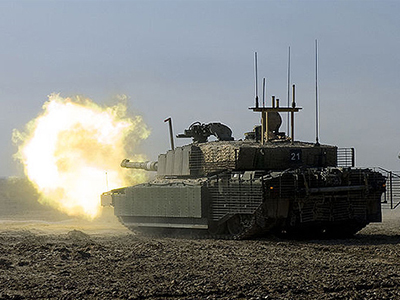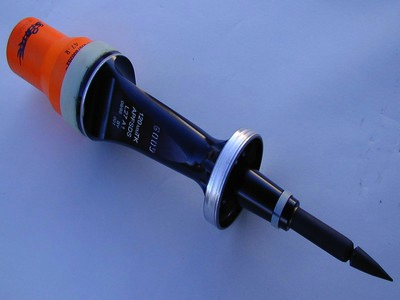the UK DU armaments
The most recent rounds used by the UK military, and fired from Kirkcudbright are most likely to be L27 APFSDS (Armour Piercing Fin Stabilised Discarding Sabot) rounds with a Depleted Uranium penetrator, known as CHARM3. It is fired from the Challenger 2 tank. Development of these penetrators began in the early 1990’s, and they first became available in 1999. The constituents of the shells fired prior to this are not publicly known.


From ICBUW: bandepleteduranium.org
‘The L27 is distinctive amongst APFSDS rounds, as it is fired from a rifled barrel, and because the round is comprised of a separate projectile and charge. L27 is the designation of the projectile. It is fired using either an L16 or L17 charge.
‘Each penetrator weighs about 4.5 kg, has a radius of 1.5cm and a length of 30 cm. The L27 was deployed in the 2003 Iraq war, where 1.9 tons of DU were fired by UK troops, according to UK government figures. This equates to around 420 rounds.
‘In 2010 the UK government announced, as part of the Strategic Defence and Security Review (SDSR) that the UK Challenger 2 fleet would be cut by about 40% to around 230. There have also been suggestions that further cuts to the fleet may be made in the future. The Challenger 2 is expected to remain in service until around 2035, but the shelf life for the L27s charges is due to expire around 2015.’
effects of DU in humans
The research on the health effects on humans, mostly male military personnel, following the two Gulf Wars and the wars in Kosovo and the former Yugoslavia has been contentious. The findings vary from those that claim DU presents no significant health hazard, to those that find evidence of continued harm in the form of cancers, genetic malfunctions and other illnesses, some of which take up to 20 years to manifest.
I don’t propose to set out the range of findings; see references. I offer here a brief summary of how DU may affect the human body. The ‘sample’ body in most findings is a healthy, early adult, male person: the combat troops rather than the civil populations who are collateral targets. There are studies, too, of US troops who survived the effects of ‘friendly fire’. How DU may affect other organisms, including marine organisms, cannot be surmised from this sample any more than the variations of how pregnant women, children, older men may be affected. The metrics are not calculated in that way. But the summary gives an idea of how, in one species of mammal, the contact or ingestion of DU may have effect on the organs and soft tissues of life.
Alpha-, beta- and gamma-radiation behave differently within the human body. The example here is alpha-radiation which travels a very short distance in tissue or in water, and releases its energy within a small area, tens of microns. It probably would not penetrate the skin. An injury which could take alpha particles into the bone marrow and body tissue would present a hazard. If ‘dust’ particles are inhaled, the alpha-radiation and accompanying radon gas could exposure organs to radiation, causing lung cancers, lymphomas. When inside the body, as an alpha-emitter, DU is classed as a Group 1 Carcinogen by the World Health Organisation’s International Agency for Research on Cancer.
When the chemical toxins of Depleted Uranium enter biological fluids, it migrates to the liver and kidneys; much of the research on US troops has been done on the kidneys as an indicator of exposure and potential harm.
There has been increasing independent, peer-reviewed research which confirm overall that DU is a genotoxic agent, that it is capable of damaging DNA, which can lead to the development of cancers. As to radiation-related cancers, the time-lags between exposure and the cancer being detectable varies. Thyroid disorders and radiation-induced leukaemias may occur in the first 5 years; other cancers may take 20 years or more to develop.
effects of DU in terrestrial and marine environments
The effects on other-than-human living beings, on soils and on freshwater courses are less well researched. Environments are highly variable, and the range of environmental factors considerable. Each environment is specific, as is each species, as are the inter-dependencies between them. It is accepted that contamination is persistent in the terrestrial environment; that it can affect watercourses on land; that it can affect other-than-human life on land.
Even less well researched are the effects on marine environments, whether within or outside the zones of conflict.
There has been monitoring by the Defence Science and Technology Laboratories for the UK MOD of the terrestrial and marine environments. Some of those documents are publicly available. The scope of the research can be considered limited as to is geographic range, the timescales involved, and whether the methodologies are sufficiently comprehensive. See references. Too, there are questions over the impartiality of the DSTL research as opposed to academic peer-review research, which find a considerably greater level of uncertainty prevails given the turbulence of the estuarine and marine environments.
There are some indications that the dispersal of the sea does not dilute, but spreads the DU thinly, thinly enough to enter the soft tissues of the endless unnamed life forms that inhabit a place where human soft tissues do not go. There are no safe levels, no metrics of contamination which apply for all living beings; that is a logical impossibility. The vulnerabilities are variable. The dumping of DU into the sea is an experiment without a control, an act directly into nature, with no method of retrieval.


